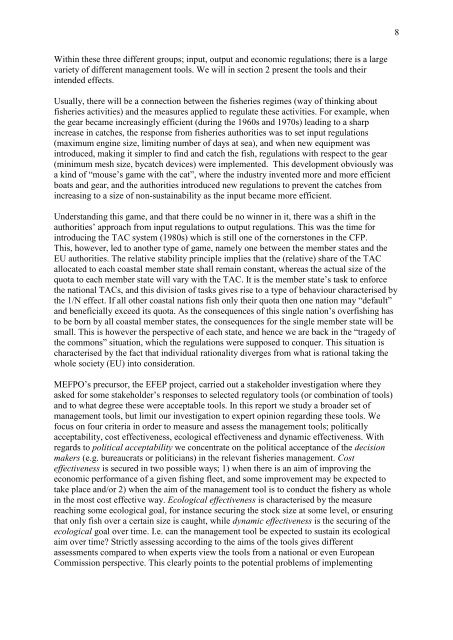Operational tools and adaptive management
Operational tools and adaptive management
Operational tools and adaptive management
Create successful ePaper yourself
Turn your PDF publications into a flip-book with our unique Google optimized e-Paper software.
Within these three different groups; input, output <strong>and</strong> economic regulations; there is a large<br />
variety of different <strong>management</strong> <strong>tools</strong>. We will in section 2 present the <strong>tools</strong> <strong>and</strong> their<br />
intended effects.<br />
Usually, there will be a connection between the fisheries regimes (way of thinking about<br />
fisheries activities) <strong>and</strong> the measures applied to regulate these activities. For example, when<br />
the gear became increasingly efficient (during the 1960s <strong>and</strong> 1970s) leading to a sharp<br />
increase in catches, the response from fisheries authorities was to set input regulations<br />
(maximum engine size, limiting number of days at sea), <strong>and</strong> when new equipment was<br />
introduced, making it simpler to find <strong>and</strong> catch the fish, regulations with respect to the gear<br />
(minimum mesh size, bycatch devices) were implemented. This development obviously was<br />
a kind of “mouse‟s game with the cat”, where the industry invented more <strong>and</strong> more efficient<br />
boats <strong>and</strong> gear, <strong>and</strong> the authorities introduced new regulations to prevent the catches from<br />
increasing to a size of non-sustainability as the input became more efficient.<br />
Underst<strong>and</strong>ing this game, <strong>and</strong> that there could be no winner in it, there was a shift in the<br />
authorities‟ approach from input regulations to output regulations. This was the time for<br />
introducing the TAC system (1980s) which is still one of the cornerstones in the CFP.<br />
This, however, led to another type of game, namely one between the member states <strong>and</strong> the<br />
EU authorities. The relative stability principle implies that the (relative) share of the TAC<br />
allocated to each coastal member state shall remain constant, whereas the actual size of the<br />
quota to each member state will vary with the TAC. It is the member state‟s task to enforce<br />
the national TACs, <strong>and</strong> this division of tasks gives rise to a type of behaviour characterised by<br />
the 1/N effect. If all other coastal nations fish only their quota then one nation may “default”<br />
<strong>and</strong> beneficially exceed its quota. As the consequences of this single nation‟s overfishing has<br />
to be born by all coastal member states, the consequences for the single member state will be<br />
small. This is however the perspective of each state, <strong>and</strong> hence we are back in the “tragedy of<br />
the commons” situation, which the regulations were supposed to conquer. This situation is<br />
characterised by the fact that individual rationality diverges from what is rational taking the<br />
whole society (EU) into consideration.<br />
MEFPO‟s precursor, the EFEP project, carried out a stakeholder investigation where they<br />
asked for some stakeholder‟s responses to selected regulatory <strong>tools</strong> (or combination of <strong>tools</strong>)<br />
<strong>and</strong> to what degree these were acceptable <strong>tools</strong>. In this report we study a broader set of<br />
<strong>management</strong> <strong>tools</strong>, but limit our investigation to expert opinion regarding these <strong>tools</strong>. We<br />
focus on four criteria in order to measure <strong>and</strong> assess the <strong>management</strong> <strong>tools</strong>; politically<br />
acceptability, cost effectiveness, ecological effectiveness <strong>and</strong> dynamic effectiveness. With<br />
regards to political acceptability we concentrate on the political acceptance of the decision<br />
makers (e.g. bureaucrats or politicians) in the relevant fisheries <strong>management</strong>. Cost<br />
effectiveness is secured in two possible ways; 1) when there is an aim of improving the<br />
economic performance of a given fishing fleet, <strong>and</strong> some improvement may be expected to<br />
take place <strong>and</strong>/or 2) when the aim of the <strong>management</strong> tool is to conduct the fishery as whole<br />
in the most cost effective way. Ecological effectiveness is characterised by the measure<br />
reaching some ecological goal, for instance securing the stock size at some level, or ensuring<br />
that only fish over a certain size is caught, while dynamic effectiveness is the securing of the<br />
ecological goal over time. I.e. can the <strong>management</strong> tool be expected to sustain its ecological<br />
aim over time? Strictly assessing according to the aims of the <strong>tools</strong> gives different<br />
assessments compared to when experts view the <strong>tools</strong> from a national or even European<br />
Commission perspective. This clearly points to the potential problems of implementing<br />
8

















